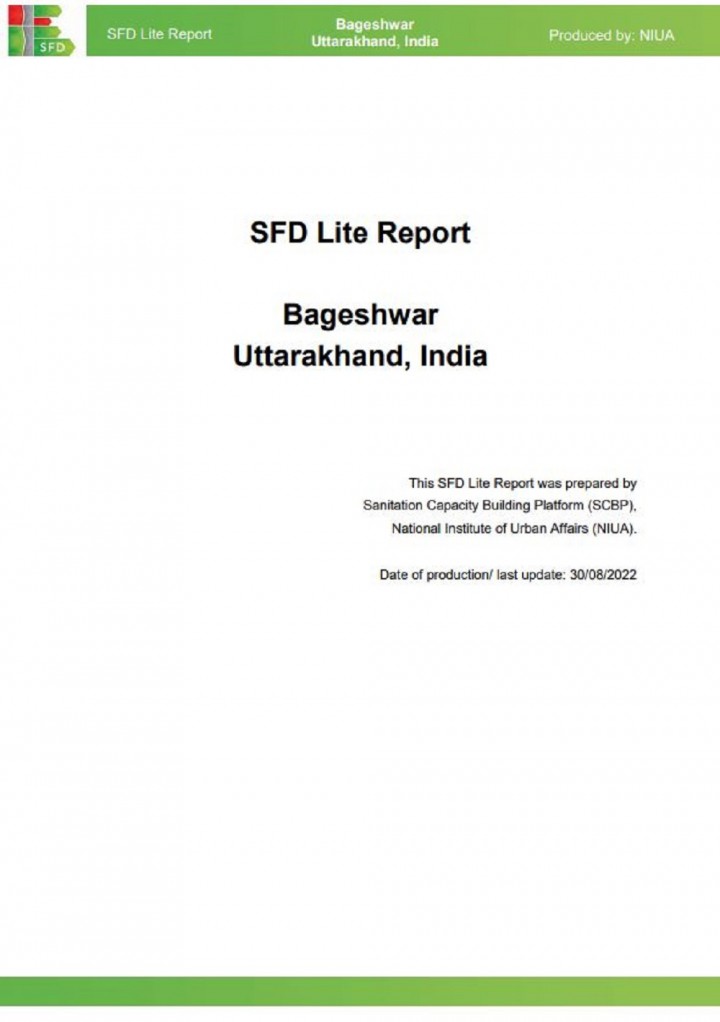
Published in: 2022
Pages: 11
Publisher:
National Institute of Urban Affairs (NIUA)
Author:
NIUA
Uploaded by:
SuSanA Admin
Partner profile:
common upload
1385 Views
63 Downloads
Bageshwar Nagar Palika Parishad area is 8.5 sq.km. and has 11 wards with a population of 25,045 (as of year 2018). There are 4,808 Households (HHs) post municipal boundary expansion in the year 2018. With the delimitation of boundary, the total number of wards have increased from 7 to 11. Presently, the geographical area of the city is 8.5 Km2. The revised municipal boundary has been considered for the current study. The average household size is 5.21.
The output of the SFD graphic represents that only 13% of the human excreta flow is attributed to be safely managed and the remaining 87% is unsafely managed. The unsafely managed excreta of 87% is contributed by onsite sanitation. Under onsite component i.e., 100%, - FS contained is attributed by 26% of the population which constitutes septic tank connected to soak pit (T1A2C5), 6% and 20% from lined tanks with impermeable walls and open bottom, no outlet or overflow (T1A4C10). FS not contained is attributed by 74% of the population - FS contributed from containments – fully lined tanks, partially lined tanks and pits, and unlined pits- failed, damaged, collapsed or flooded - with no outlet or overflow (T1B10C10) constitutes to 40%, fully lined tanks (sealed) connected to a soak pit, where there is a 'significant risk' of groundwater pollution (T2A3C5) constitutes 14% and lined tanks with impermeable walls and open bottom, no outlet or overflow, where there is a 'significant risk' of groundwater pollution (T2A4C10) is attributed by 20% of the population. Henceforth, it is assumed that 50% of FS is emptied in case of FS contained, thus 13% (3% from septic tank system +10% lined tank system) is emptied and the remaining 13% FS is contained but not emptied and it represents the portion of FS which remains in tanks and infiltrate into the ground but not contaminating the groundwater table hence represented safe (green arrow). FS not contained – emptied is 30%. It constitutes 50% of FS emptied i.e., 20% from damaged or collapsed systems and 10% from lined tank systems. Faecal Sludge (FS) emptied but not delivered to treatment, hence discharged in the neighbourhood is attributed by 43% (30% + 13%) of the population. Thereby, the remaining 44% of the population’s FS is not contained not emptied. No Supernatant (SN) is generated from the systems (septic tanks to soak pit + fully lined tank sealed with no outlet or overflow + lined tanks with impermeable walls and open bottom; and all types of pit) as 100% proportion of the content in the tank is FS and 0% is SN.
Bibliographic information
NIUA (2022). SFD Lite Report – Bageshwar, India. National Institute of Urban Affairs (NIUA)
Filter tags
English Politicians and local decision makers Practitioners SFD Report South Asia














